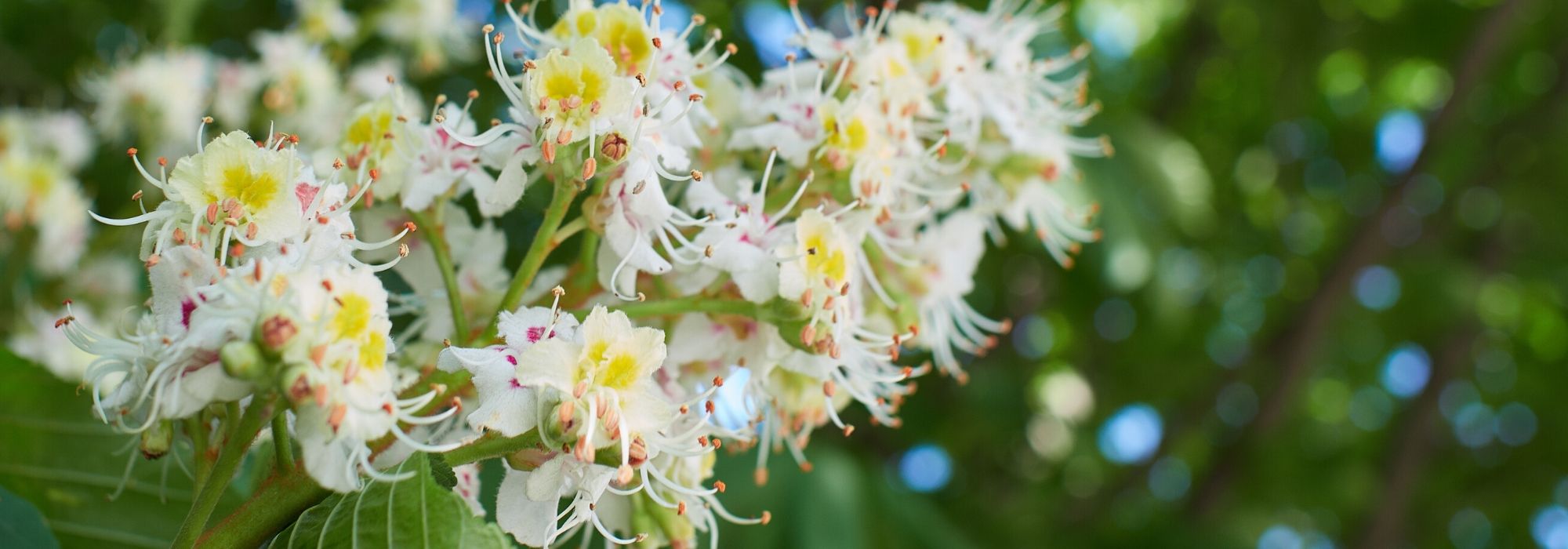
Horse chestnut, Aesculus hippocastanum: planting, growing and care
Contents
Aesculus in a nutshell...
- Horse chestnuts are handsome trees, well known for their fruit, conkers sometimes mistaken for chestnuts.
- Horse chestnut is well known, but other species and more compact varieties exist.
- These trees or bushes are planted for their colour-changing foliage and spectacular flowering.
- Horse chestnuts and buckeyes like to grow in sun or semi-shade; they prefer rich, deep, moist soils.
- Flowering attracts many butterflies.
A word from our expert
Ah Aesculus… These charming trees and bushes are… What do you mean: what? Oh yes, true, they are seldom called by their genus name… But if I say “pavier” or, above all, “horse chestnut”. Ah there you go! That rings a bell.
The best-known of them, the horse chestnut, found in our parks and along avenues, is far too imposing to find a place in our gardens despite its spectacular flowering. No need to panic, however: other, much more compact Aesculus exist.
Like the simple but always effective white buckeye or Aesculus parviflora, which forms a bush wider than tall with foliage first bronze then dark green and finally yellow in autumn. Or a charming dwarf horse chestnut Aesculus mutabilis ‘Induta’, a deciduous bush with a rounded crown that will never exceed 2.50 m in height, with palmate leaves of a lovely lime-green that provide a setting for a superb spring flowering in candle-shaped spikes from red to salmon-pink. Another quite astonishing horse chestnut is Aesculus neglecta, which is a small tree but with slow growth and will not exceed ten metres in height, splendid in spring with young bronze-copper leaves that turn light green in summer before taking on a flamboyant red‑orange autumn display.
In short, don’t stop at the horse chestnut when Aesculus are mentioned. There are several different species and varieties that can be accommodated without problem in the smallest gardens. Each has its own assets: foliage, form and flowering.
All horse chestnuts should be planted in sun or partial shade. These bushes or small trees like to grow in any soil provided it is sufficiently rich, deep and remains cool.
Note that Aesculus flowering is not just for show: fragrant flowers attract many butterflies and other pollinating insects.
Botany and description
Botanical data
- Latin name Aesculus sp.
- Family Sapindaceae
- Common name Horse-chestnut, Red buckeye
- Flowering April to June depending on species
- Height 2 m to 30 m depending on species
- Exposure full sun or partial shade
- Soil type well-drained, rather rich and moist
- Hardiness at least -15°C
Genus Aesculus comprises about thirty species of trees or bushes, most of which originate from North America: these are the buckeyes. Other species come from Europe and temperate Asia: these are the horse-chestnuts. Formerly included in family Hippocastanaceae, the genus is now placed in family Sapindaceae according to the APG III classification: nothing to do with firs, the name refers to genus Sapindus, the soap tree of Asia.
The horse-chestnut (Aesculus hippocastanum), the tree most people think of when speaking of horse-chestnuts, is an imposing tree that can reach 40 metres and develops a globular crown on a high trunk. Alongside this giant, there are also dwarf horse-chestnuts or buckeyes, often from North America, sometimes not exceeding two metres in height and with a very rounded habit.
Bark ranges from smooth brown-grey (e.g. Aesculus indica) to deeply fissured (e.g. Aesculus × carnea) depending on species. Buds are reddish-brown, sometimes sticky, and protected by two layers of scales.
Foliage is deciduous, opposite and long-petiolate. Leaves are compound, made up of 5 to 7 petiolulate or sessile leaflets. Leaflets are, depending on species, oblong (longer than wide with rounded ends) to elliptical (length about twice width with tapering ends), often dentate, glabrous beneath and hairy along veins. Central leaflets are longer than lateral ones, the whole leaf resembling a hand. At bud burst, leaves may be pink-tinged, then turn bright green in summer and finally take warm autumn hues: yellow, orange and sometimes red depending on species and cultivars.
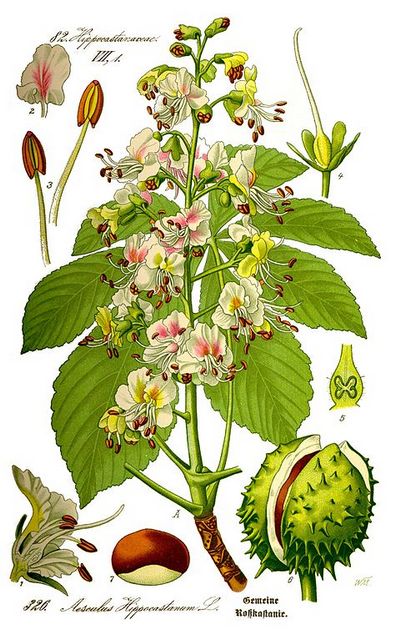
Aesculus hippocastanum – botanical illustration
Inflorescences of Aesculus are called thyrsi. These erect, pyramidal thyrsi develop in spring (between April and June). On a single plant, hermaphrodite flowers as well as male or female flowers may occur: this condition is known as trimonoecy. In fact, male flowers possess aborted female floral parts and vice versa. Horse-chestnuts and buckeyes are insect-pollinated, they need insects for pollination. That is why the flowers are highly perfumed and nectariferous.
Each flower has a bell-shaped calyx with five unequal teeth. The corolla consists of 4 to 6 unequal petals in white, yellow, pink or red, often with two spotted petals: yellow spots on petals turn red when a flower has been pollinated, signalling to visiting insects that the flower no longer produces nectar. Insects see yellow but not red. Stamens number 5 to 9 and vary in length according to species. The rest of the flower is formed by a pistil with three fused carpels, topped by a style as long as the stamens and a stigma acute or bifid.
Fruits resulting from fertilization are actually dry, dehiscent capsules: the burrs form the fruit covering and derive from transformation of the carpel wall (note: the burr of sweet chestnuts, by contrast, comes from transformation of the flower bracts). These burrs differ by species: sometimes bristly-pointed or simply smooth, and of oval, round or pyriform (pear-shaped) form. Burrs contain a seed (occasionally two, but rare): the conker. Dehiscent, they generally open along three seams corresponding to the three carpels. Dispersal is, as you can imagine, barochorous, meaning the fruit falls by gravity at the foot of the parent plant. Unless you retained the childhood habit of filling pockets with conkers and… losing them everywhere afterwards.
Growth of these trees and bushes is, with few exceptions, quite fast. Trees can live between 200 and 300 years, while bushes average around 50 years. Sexual ripeness in horse-chestnut reaches roughly 15 to 20 years.
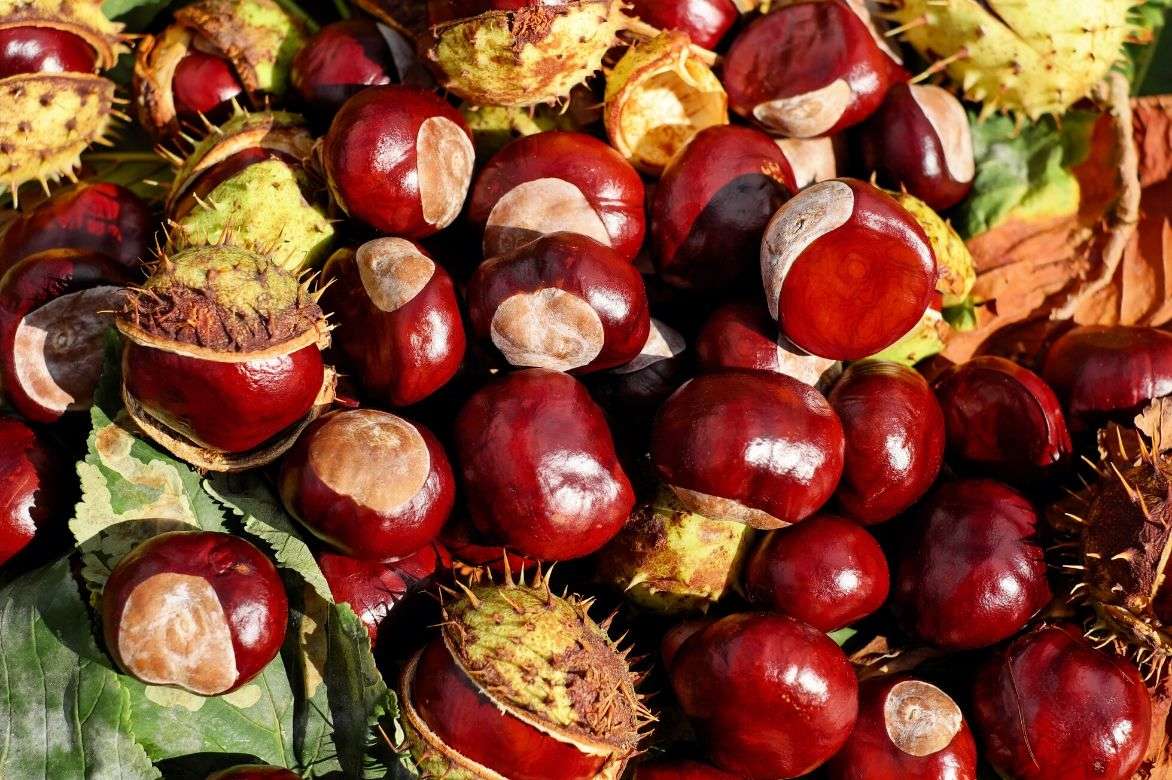
Fruits of horse-chestnut: the famous conkers and their burrs!
Short overview of main species
Aesculus hippocastanum
Horse-chestnut is widely used as an avenue tree or large park tree. Paradoxically, it is rather sensitive to urban pollution, not to mention the diseases that affect it. A fairly tall tree, up to 30 m with a spreading rounded crown. Flowering from May to June is scented and ranges from white-yellow to orange-red.
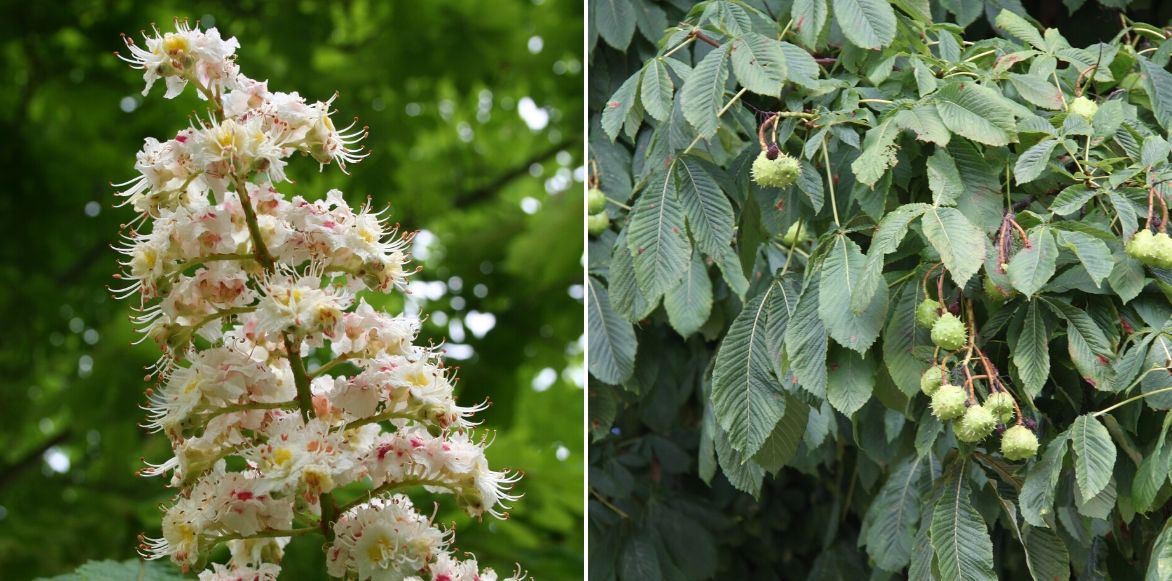
Aesculus x carnea
This horse-chestnut is a hybrid between Aesculus hippocastanum and Aesculus pavia, appearing in the early 20th century. It is smaller than horse-chestnut, about 9 m tall, but tolerates drought better than the latter. Foliage is mid-green with sticky buds. Flowering is pink and appears in May–June.
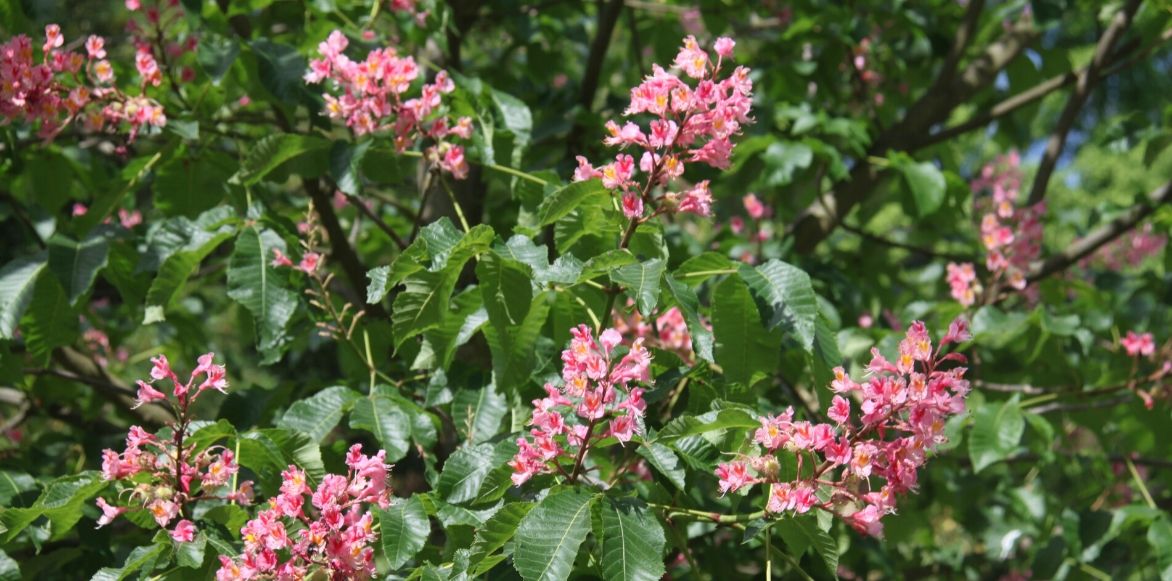
Aesculus pavia
This small horse-chestnut, rather a red buckeye, is native to the eastern United States and easy to grow. It is hardy enough to be cultivated widely here. A tree of about 7 m or a bush of 3 m depending on cultivar. Leaves are made of small 5-leaflet leaves that turn a fabulous red in autumn. In June, a mass of tubular scarlet flowers appears.
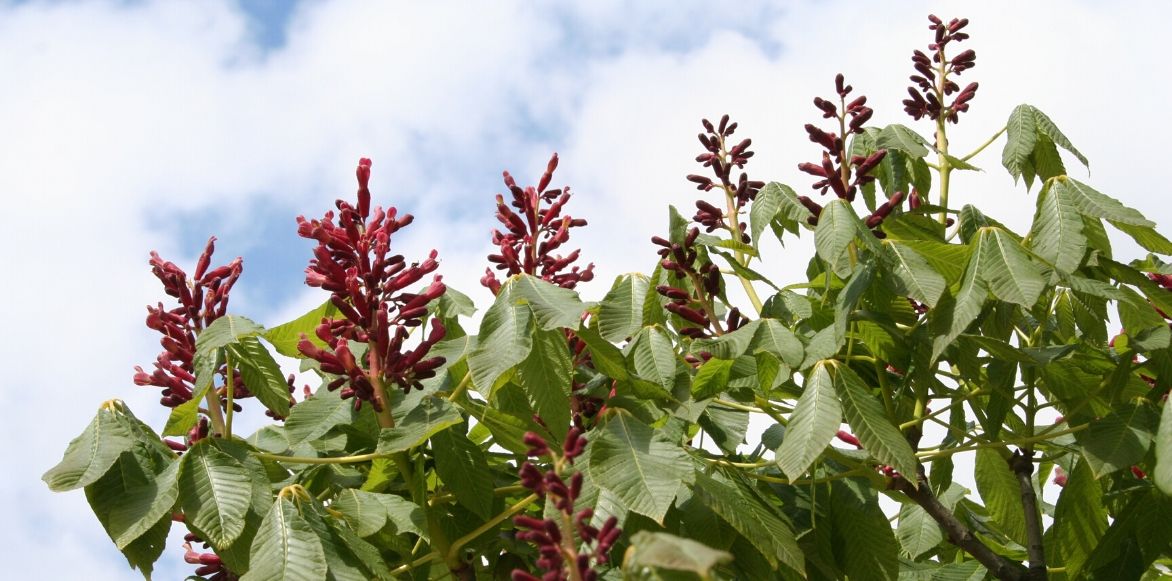
Aesculus parviflora
The white buckeye is native to the southeastern United States, from Georgia to Florida. It is a suckering horse-chestnut forming a large, dense, rounded bush up to 4 m wide and 2.5 m high. Deciduous leaves emerge bronze-tinged then turn dark green before turning golden yellow in autumn. In June–July, splendid erect 30 cm spikes resembling candelabra and white in colour with bright red stamens appear. They attract many butterflies. Note that conkers are small with light-brown skin and enclosed in a pear-shaped, non-spiny burr.
Aesculus indica
This tree grows on Himalayan slopes and is an endangered species in its natural habitat. It is perfectly hardy and readily grows to about 20 m. Summer flowers are delicate and pinkish-white.
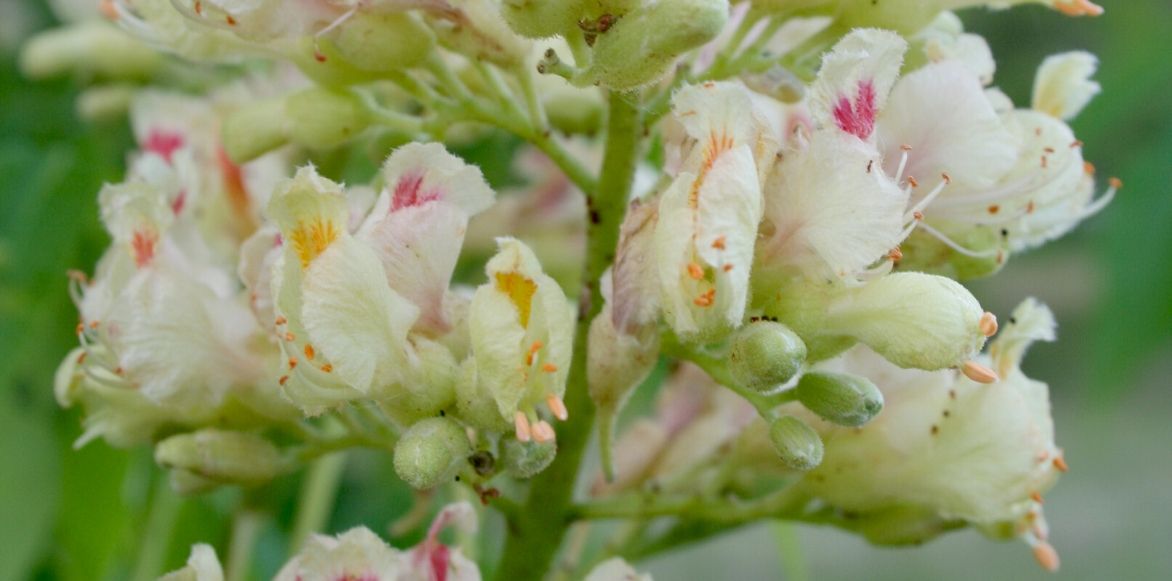
Aesculus californica
This small tree is particularly drought-tolerant. Its relatively small size, up to 5 m, makes it suitable for small gardens. Foliage is grey-green and flowers are scented, creamy with pink tinges.
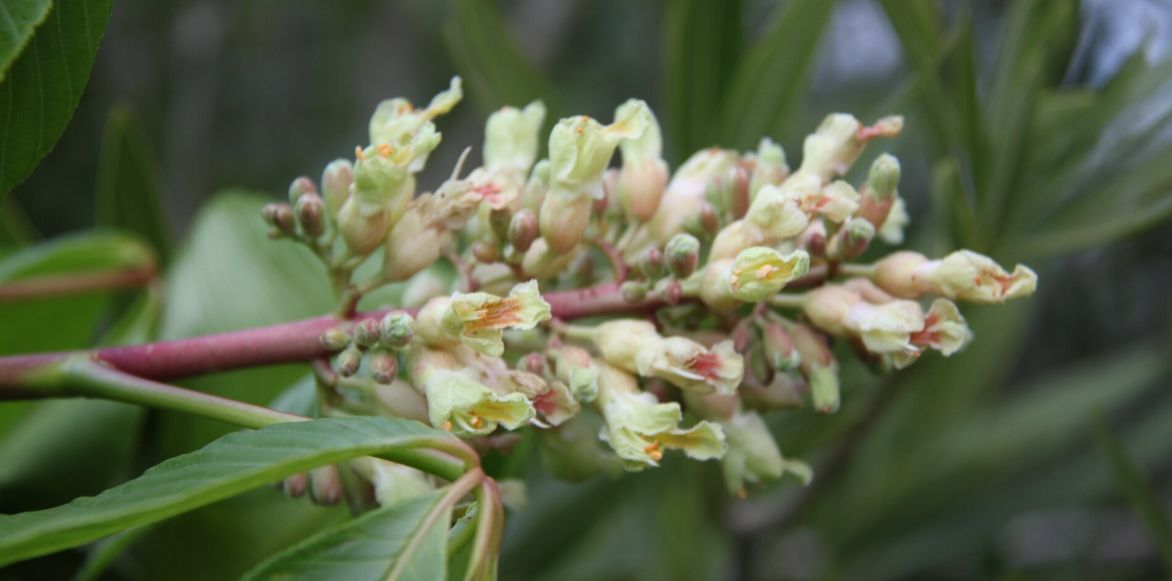
Aesculus flava
A large horse-chestnut nicknamed the yellow buckeye because of its yellow flowers. It can reach up to 25 m in cultivation with a 15 m spread.
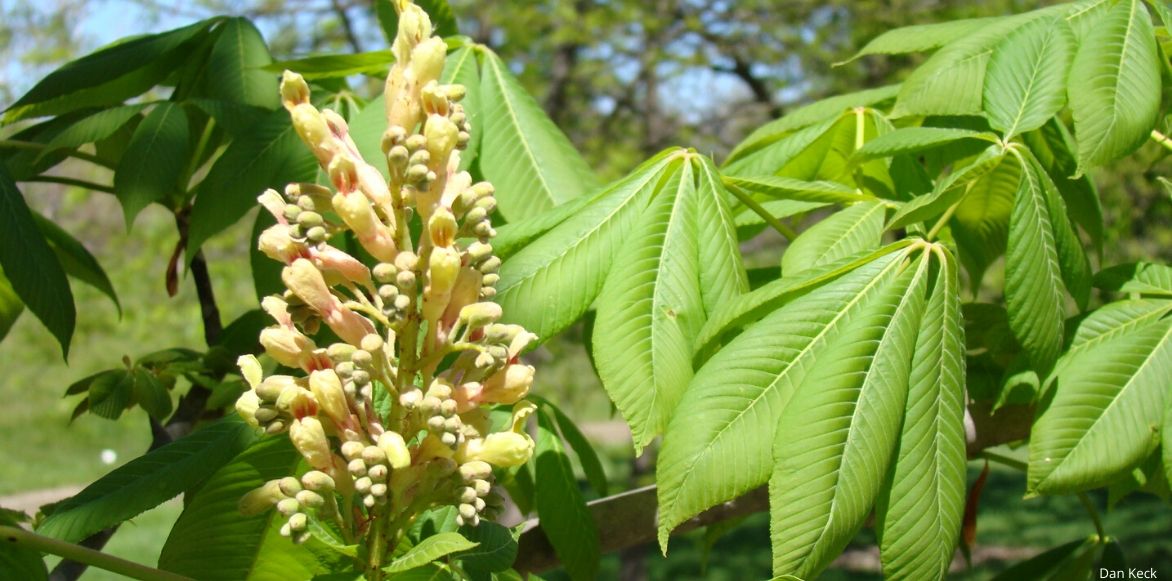
Aesculus mutabilis
Aesculus (×) mutabilis is a hybrid between compact Aesculus sylvatica, native to Appalachian forests of the United States, and Aesculus pavia. It is a small shrubby horse-chestnut about 2 m high and 2 m across, fully hardy. Deciduous leaves are lime-green with bluish tints and colour superbly to yellow or orange-pink in autumn. Small flowers appearing in May–June are dark pink to salmon, the salmon tone resulting from small yellow zones at their tips.
Aesculus neglecta
Aesculus (×) neglecta is a recent horticultural hybrid with the same parents as the hybrid cited above, yet notably different. This medium-sized horse-chestnut forms a trunk topped by a rounded crown, reaching about 6 m high and 3 m wide in 10 years. Young shoots, remarkably coloured, unfold into large palmate leaves that quickly turn light green. By mid-September, this bush dons a red–orange autumn coat. Inflorescences in the form of small erect panicles of 10–15 cm open between May and June. Flowers are pale yellow, then deepen to salmon-pink.
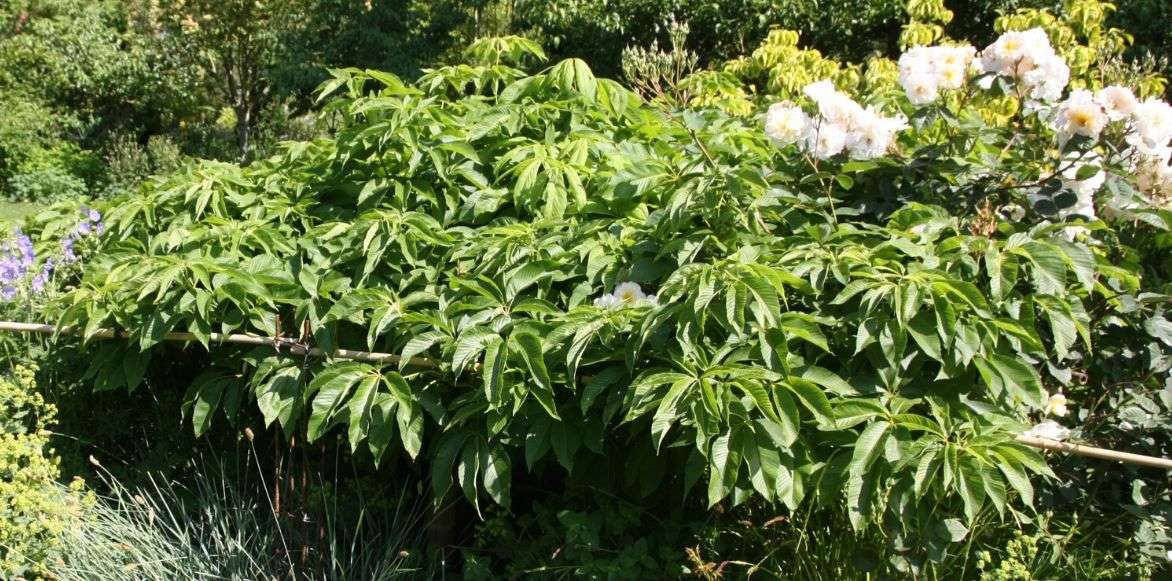
Our best varieties
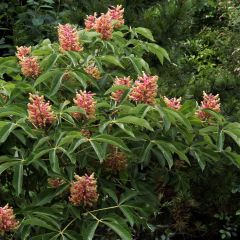
Aesculus pavia var. discolor Koehnei
- Flowering time June, July
- Height at maturity 3 m
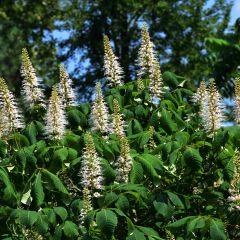
Aesculus parviflora
- Flowering time August, September
- Height at maturity 3,50 m
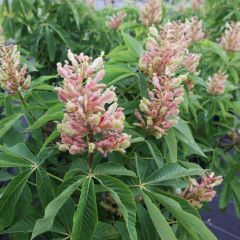
Aesculus mutabilis Induta
- Flowering time June, July
- Height at maturity 2,25 m
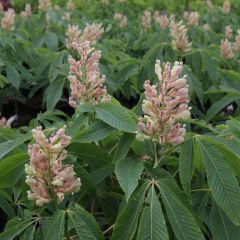
Aesculus neglecta Autumn Fire
- Flowering time June, July
- Height at maturity 9 m
Discover other Aesculus - Horse Chestnut
View all →Available in 3 sizes
Available in 1 sizes
Available in 1 sizes
Available in 1 sizes
Available in 1 sizes
Available in 1 sizes
Available in 1 sizes
Available in 1 sizes
Available in 1 sizes
Available in 1 sizes
Planting
Where to plant your horse chestnut?
As a general rule, horse chestnuts or paviers are planted in any deep, well-drained soil remaining cool even in summer.
They are all hardy enough to grow anywhere in France and Belgium but they dislike seaside areas because of sea spray. They prefer areas with distinct seasons: cold winter and hot summer.
Horse chestnuts should be planted in full sun or partial shade. Only white Paviers can thrive in full shade.
Note: as with all trees, anticipate its development and choose your horse chestnut carefully according to its size and the size of your garden.
When to plant your horse chestnut?
Horse chestnuts are best planted in autumn (November) or in winter outside periods of frost. Spring planting can be considered for American horse chestnuts.
How to plant your horse chestnut?
- Immerse the pot of your new Aesculus in a bucket of water for a few minutes to re-wet the rootball
- Dig a hole twice as deep and as wide as the tree’s rootball
- Throw one or two handfuls of well-rotted compost into the bottom of the hole
- If your soil is heavy, add some gravel to improve drainage
- Start to “break up” the rootball slightly to free the roots. Do this gently by hand or with a small fork to avoid damaging the roots
- Place the remaining rootball in the bottom of the hole, spreading the roots out well
- Backfill the hole with the excavated soil that has been loosened beforehand
- Firm the soil gently around the tree with your hands (not with your feet!)
- Pour 10 litres water at the base using a watering can to reduce risk of “air pockets” between roots and soil
- Apply a mulch to protect the young tree from drought or plant directly at its base some small groundcover plants (creeping bugle, sweet woodruff, Glechoma, Geranium macrorrhizum, …)
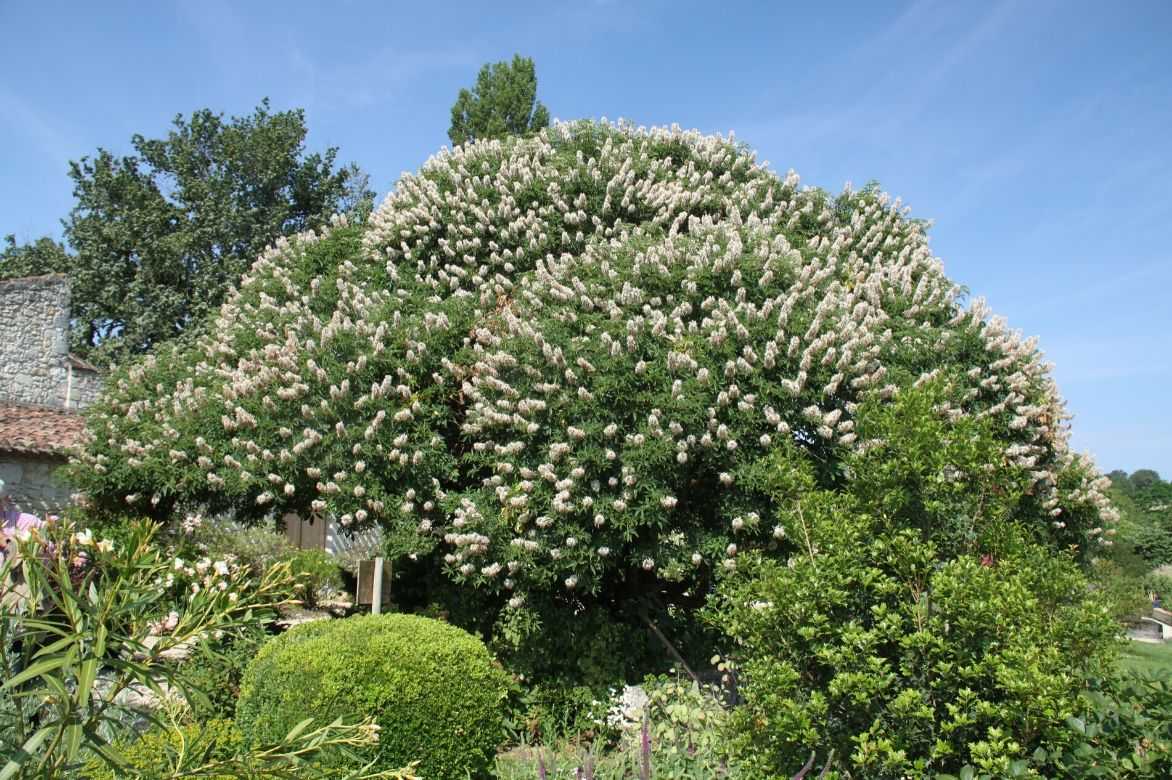
Magnificent Aesculus californica in its setting
Care and maintenance
Care
Remember to water your horse chestnut regularly during the first years after planting. These trees or bushes dislike dry soil.
Pruning
Prune only obstructive or crossing branches and any suckers on some species (notably Aesculus pavia). Avoid cutting branches over 5 cm in diameter. Horse chestnuts react poorly to pruning, which is often severe in urban environments. They form large callus ridges but the interior of the trunk or branch rots easily. Exercise caution. Best option is to choose a site with enough space for a mature horse chestnut or select a species with a smaller habit.
Potential diseases and pests
Unlike other Aesculus that hardly contract diseases or are rarely attacked by pests, Aesculus hippocastaneus or horse chestnut does face a few problems…
- Horse chestnut bacterial canker
This disease is decimating city horse chestnuts and is caused by a bacterium named Pseudomonas syringae. It is mainly found on nursery-grown horse chestnuts (thus with limited genetic mixing), those that have suffered stress (water stress, pollution, root damage) or those that have been subjected to inappropriate pruning. Symptoms are multiple: slowed bud burst period, reduced growth, presence of an oozing canker and finally desiccation of foliage on part or all of the tree. Various treatments are currently being tested without real breakthroughs, but ideally provide horse chestnuts with a healthy environment and appropriate care in advance. This will keep risk of decline to a minimum.
- Scale insects
Scale insect Pulvinaria regalis is often found on horse chestnuts without causing significant damage. Do not worry about it!
- Red leaf spot disease
In cool, wet springs, horse chestnut is sometimes susceptible to red leaf spot disease or black-rot. In early summer, leaf spots that are initially yellow then brown with yellow halos appear. These are quickly followed by desiccation and leaf fall.
This disease is especially problematic for young trees.
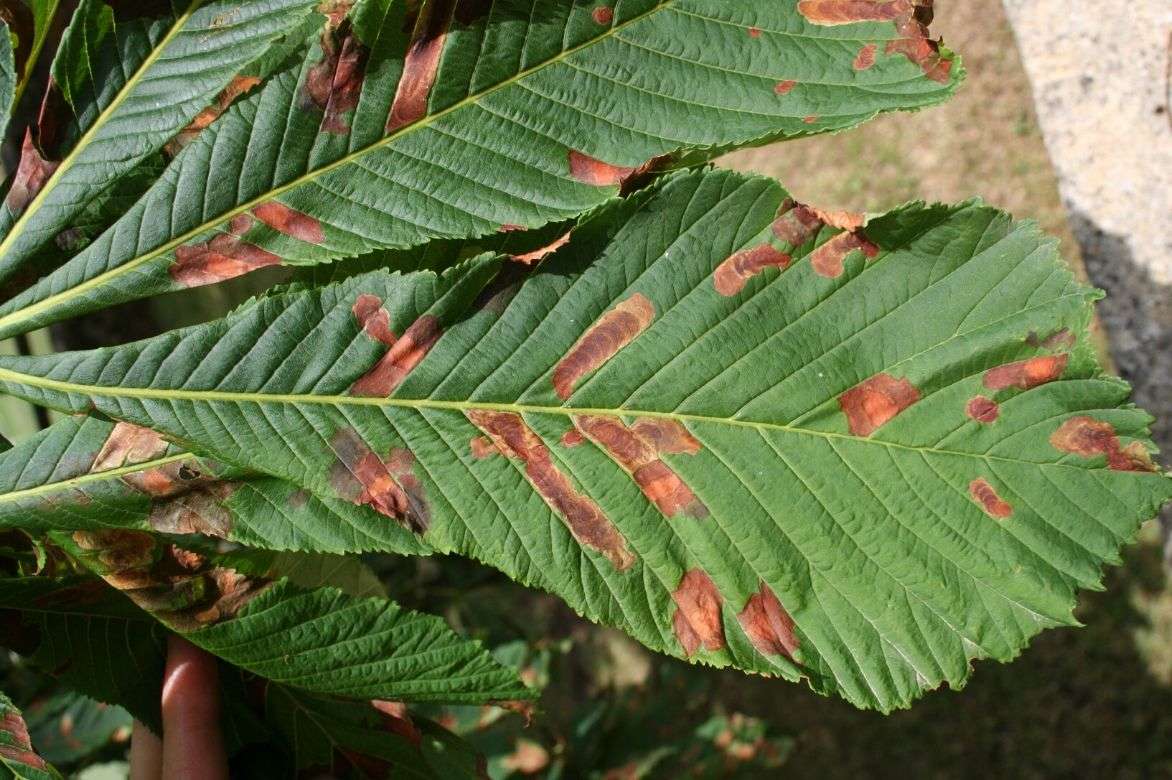
Red leaf spot disease of horse chestnut (Guinardia aesculi on Aesculus hippocastaneum)
- Horse chestnut leaf miner
Horse chestnut leaf miner (Cameraria ohridella) is a lepidopteran (moth) native to the Balkans that causes significant damage to horse chestnuts, and sometimes to Aesculus pavia. Caterpillars mine galleries in leaves, forming brown-reddish patches that lead to leaf drop during summer. Egg-laying occurs in one to three generations from April to late autumn. Larvae develop then pupate inside leaves over winter, emerging as moths in spring to restart the cycle. Best way to control this moth is to promote a garden welcoming to insectivorous birds (tits in particular) and, in severe cases, collect and burn fallen leaves to eliminate pupae.
Read also : Horse chestnut leaf miner: a pest to be feared?
Propagation of horse chestnut
By sowing
In October–November or in March, sow conkers in a substrate kept moist and fairly light: 40% potting compost, 40% pumice or sand and 20% loam. Once germination starts, in early spring the seedling will develop a strong taproot before branching. Young shoot should be placed in partial shade and sheltered from wind. Do not leave young horse chestnut in pot for too long; ideally plant in early autumn that follows in a sunny position.
By grafting
To reproduce cultivars, multiplication can be carried out using a shield graft on a Aesculus seedling rootstock. Technique is fairly complicated and should be reserved for professionals.
By separating suckers
In case of paviers germination is quite slow but fortunately the bush produces suckers that can be separated from parent plant in November or in March. To do this, dig around bush to expose one or more suckers and cut them off with spade or pruning shears.
→ Learn more in our tutorial : How to propagate horse chestnut?
Companion planting
Ideas for autumn…
Aesculus pavia ‘Koehnei‘ is a charming pavia that really reveals itself in autumn when it can offer its bright orange foliage. To accompany it, nothing beats a small tree also native to North America such as a Franklinia alatamaha. This tree has disappeared in the wild but survives in parks and gardens thanks to enthusiasts. Not only does it give red‑orange foliage in autumn, it even has the luxury of dazzling with very late flowering, sometimes lasting until the frosts, with flowers resembling single camellias: white with golden stamens. At the feet of our two companions, a carpet of Cornus canadensis, one of the rare representatives of the genus that is a perennial, will be most effective. In autumn these small miniature dogwoods do not go unnoticed when the white bracts give way to red fruit and the foliage takes on purple tones. A few tufts here and there of Deschampsia caespitosa ‘Goldschleier’ will add lightness with their large inflorescences in loose panicles where gold and silver mingle. And finally… How about trying bergenias? No, wait, don’t run away! There are now very attractive varieties that have nothing to do with bergenias of old. Like the superb variety named ‘Eden’s Dark Magic’ whose glossy dark green foliage edged with purple turns, in autumn, spectacular shades of purple and brown.
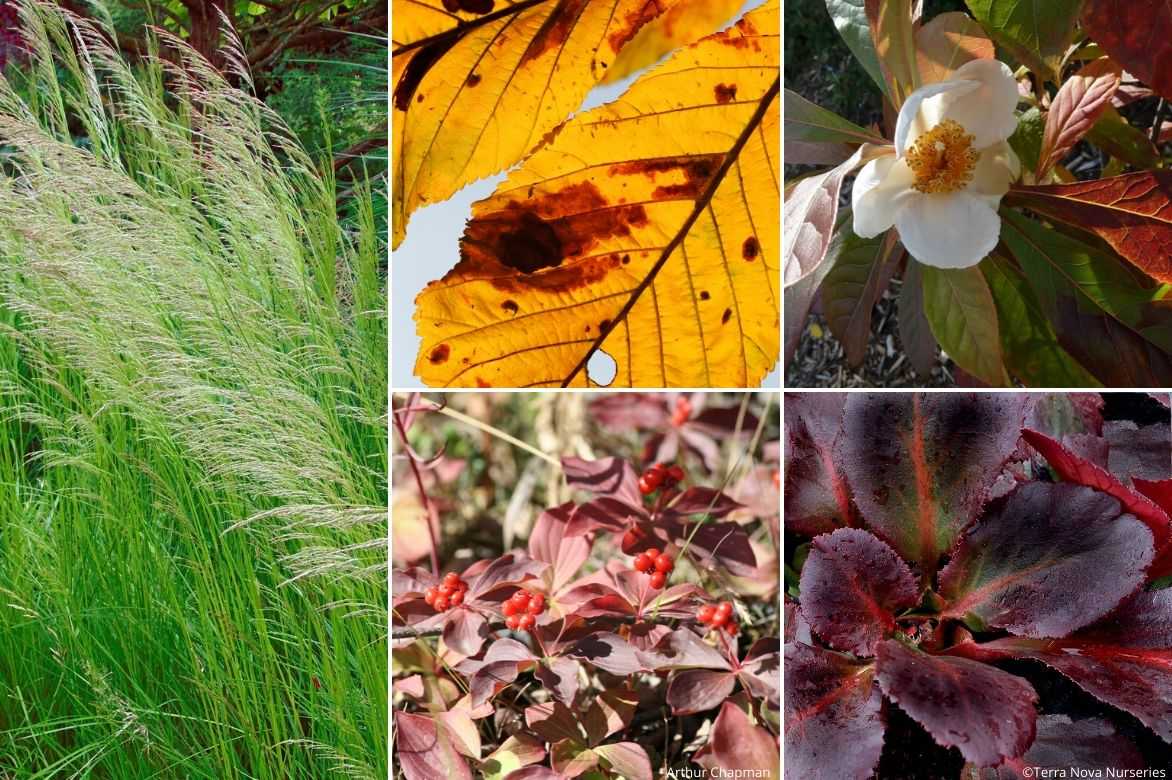
An example of an autumn combination: Deschampsia caespitosa ‘Goldschleier’, Aesculus pavia ‘Koehnei’, Franklinia alatamaha, Cornus canadensis and Bergenia ‘Dragonfly Sakura’ (or even ‘Eden’s Dark Margin’)
Or for spring…
But Aesculus are also planted for their spectacular flowering, such as the slow‑growing small tree Aesculus neglecta ‘Autumn Fire’. Its name, as you will have guessed, comes from its fiery orange autumn foliage, but it is equally beautiful in spring when its young leaves unfurl in bronze‑copper tones. A flowering soon follows, first pale yellow then salmon as days pass. It is truly a jewel to plant on its own… or not. Well accompanied, it will be even more beautiful! Some bushes with golden‑yellow foliage will respond perfectly to the young leaves and flowers of the horse‑chestnut: for example a Cornus alba ‘Aurea, a timeless classic always attractive from January to December, together with a handful of Spiraea japonica ‘Magic Carpet’ as edging. A touch of blue will be perfect to contrast with all these elements. Like our exclusive: Hydrangea macrophylla ‘The Original’ with blue flowers, a very robust and very floriferous hydrangea. Fancy blue foliage? Could a small Picea pungens ‘Glauca Globosa‘ delight you? This small conifer is a marvel in spring when it takes on bluish tones.
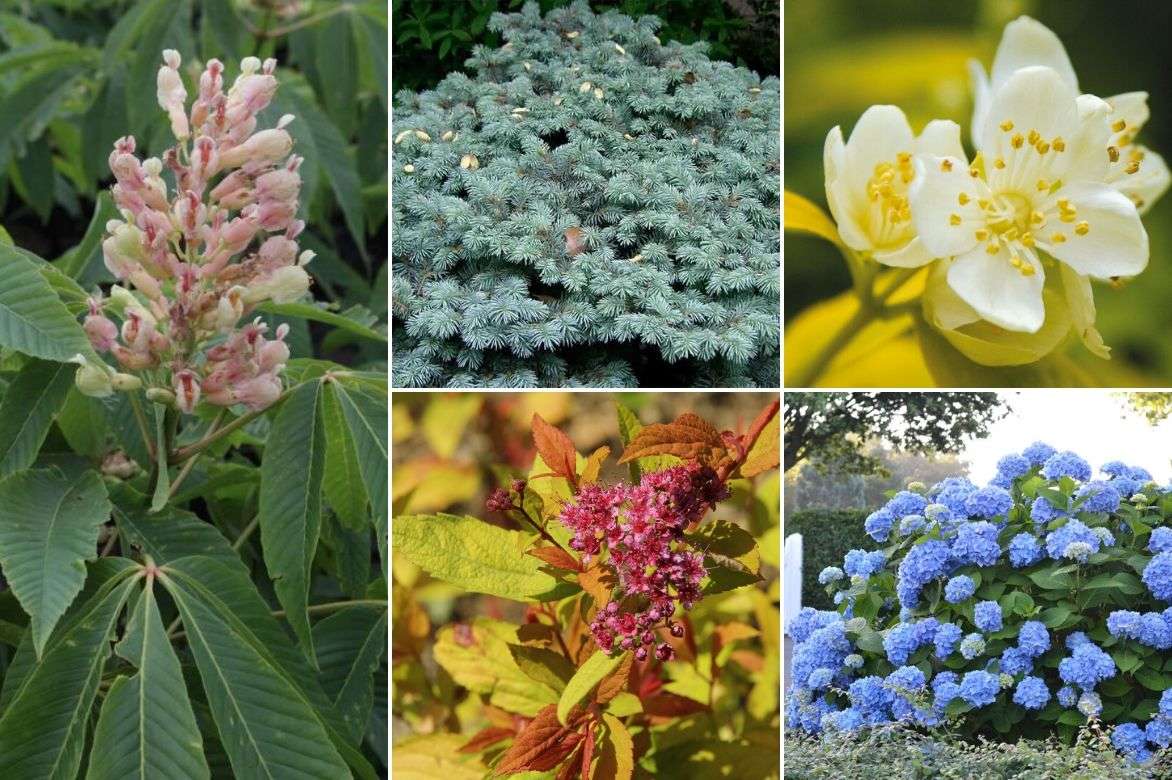
An example of a spring combination: Aesculus neglectum ‘Autumn Fire’, Picea pungens ‘Glauca Globosa’, Cornus alba ‘Aurea’, Spirea japonica ‘Magic Carpet’ and Hydrangea macrophylla ‘Endless Summer The Original’ (blue)
Did you know? To be completed
- Flowers of Aesculus are nectariferous and melliferous, but that’s not all: bud scales provide bees with propolis, a resinous substance that allows them to seal hives, plug cracks and secure wax combs.
- Botanists tore their hair out for a long time trying to determine where the horse chestnut came from. So much so that an expedition was sent to India in the 19th century in search of the tree’s origins. Without real success, although Aesculus indica, a close relative, does indeed grow in the Himalayas from Afghanistan and Pakistan to western Nepal.
- The horse chestnut became so popular that a census from 1870 shows that nearly 80% of trees planted in Paris’s public spaces were horse chestnuts.
- The genus name Aesculus actually means succulent, which is paradoxical for trees and bushes whose fruits are not edible.
- The fruit contains saponin and, during the Second World War, was used as a soap substitute. During that war, horse chestnuts were also used to prepare a nourishing starch for human consumption after treatment to remove tannic acid and that saponin. Even today in France, horse chestnuts are harvested for preparation of dry extracts.
- Aesculus parviflora was introduced to England in the 18th century thanks to British botanist John Fraser after his first trip to America and quickly became a sought-after plant in nurseries. So much so that it eventually received the Royal Horticultural Society’s (RHS) Award of Garden Merit.
- If you find yourself in a riddle contest, you can always throw out this devastating riddle to get out of it: “What’s small and brown?” The answer, of course, is: a chestnut.
Useful resources
- Find our selection of Aesculus in our nursery online!
- Advice sheet: Chestnut and horse-chestnut, what are the differences?
- Tutorial: How and when to prune a horse-chestnut?
- Advice sheet: How to choose a horse-chestnut suited to your garden?
Frequently asked questions
-
I only have a small garden. Can I plant a horse chestnut in it?
Well yes! Many American and Asian species do not exceed 3 m in height at the smaller end. Some eventually form small trees, such as Aesculus neglecta, but grow slowly and remain modest in size.
-
I've been told that horse chestnut trees are often diseased. Is that true?
In reality, it is mainly Aesculus hippocastanum, or horse chestnut, that suffers from numerous diseases and pest problems. All others are far less problematic and are trouble-free trees and bushes.
- Subscribe!
- Contents
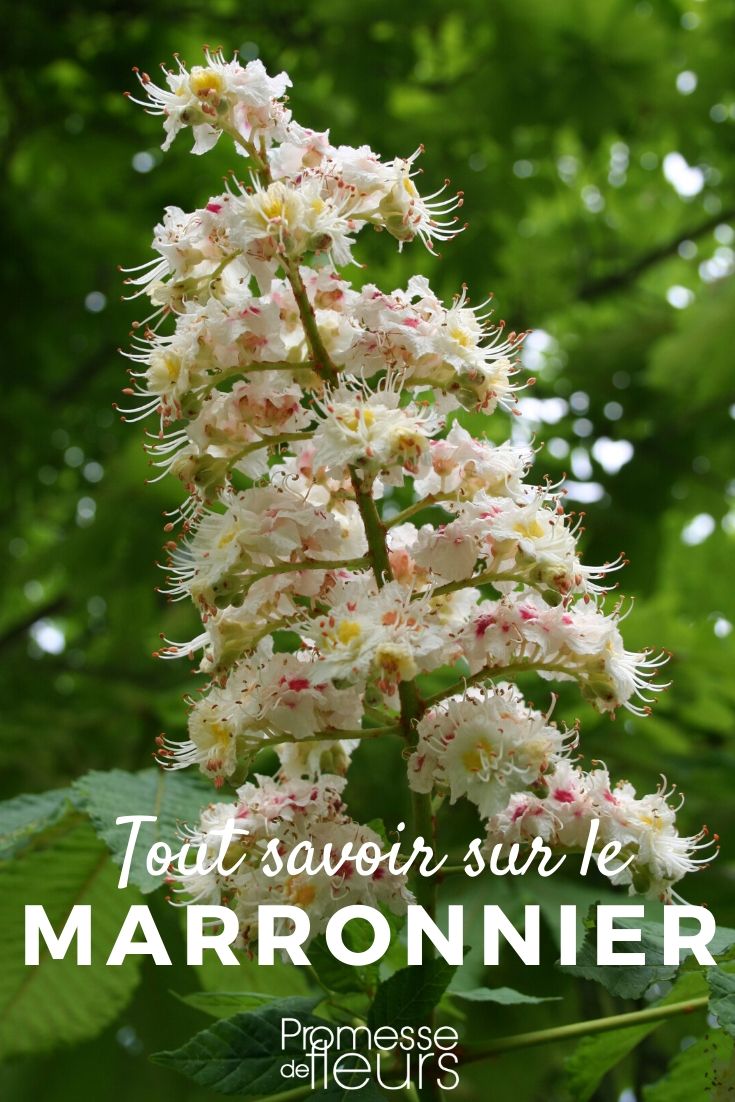































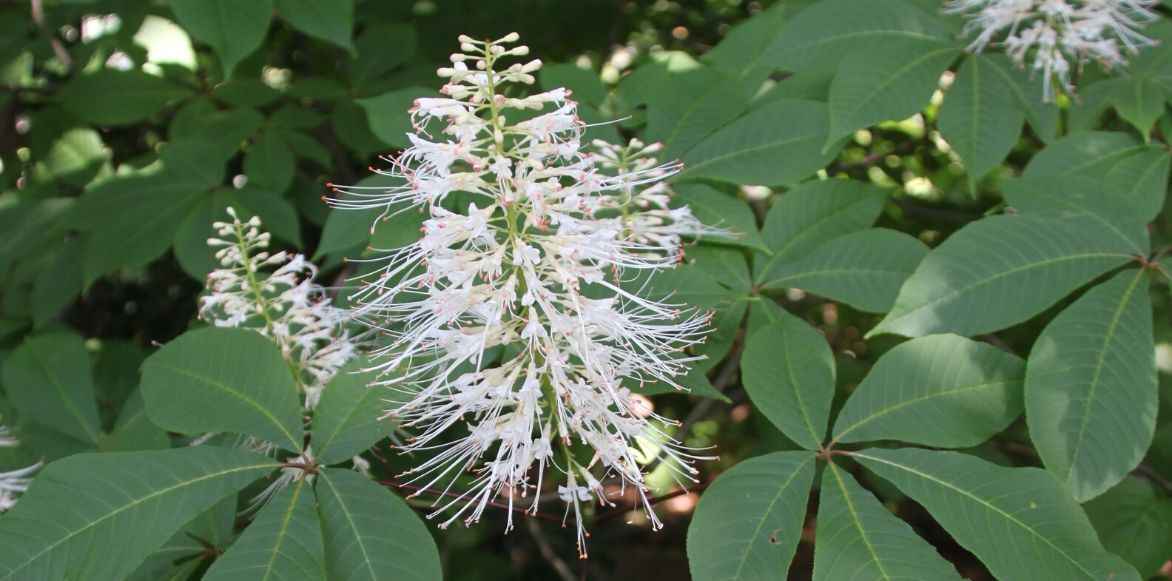
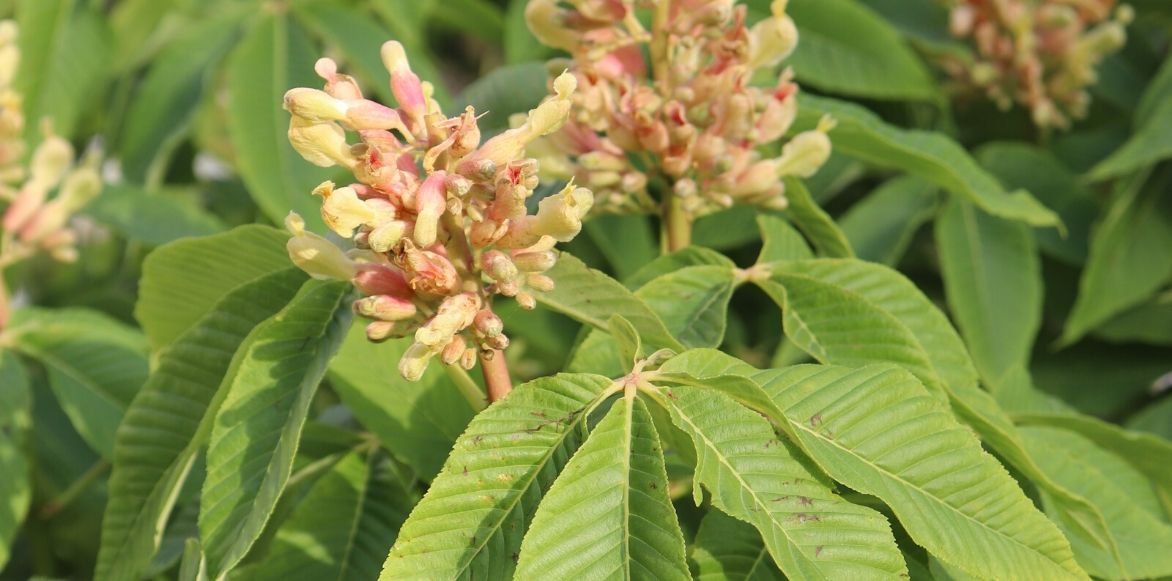

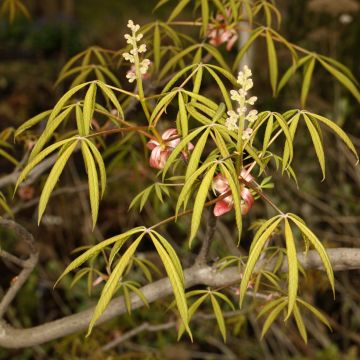



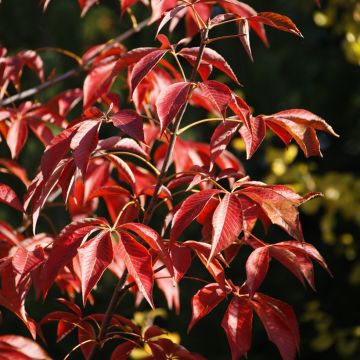
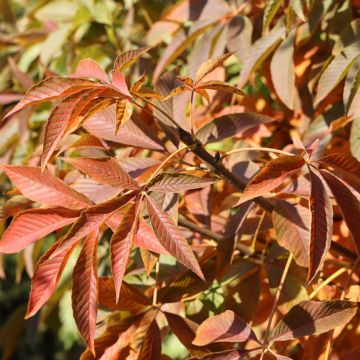
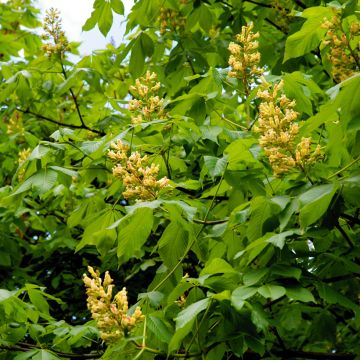
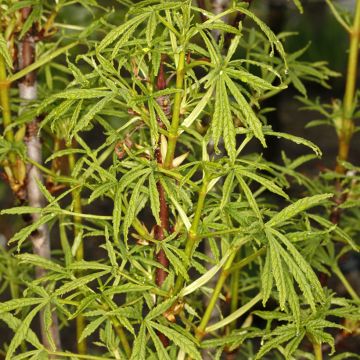

Comments